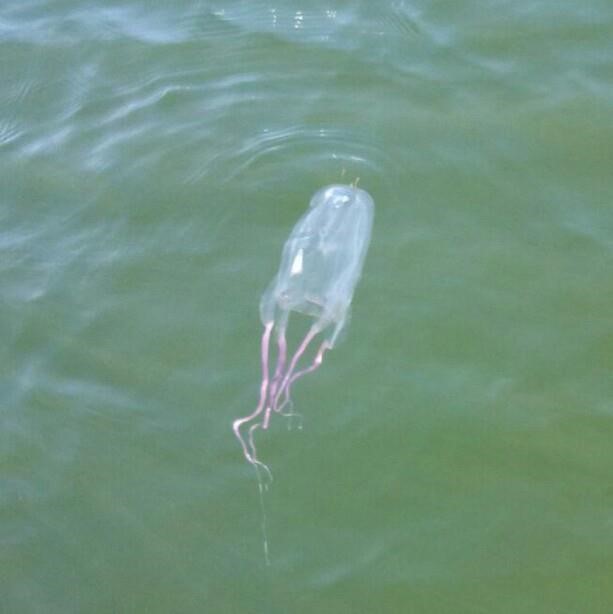
by Rick O'Connor | Dec 4, 2015
Yep, but do not get to alarmed just yet… it is not the same species as the famous one from Australia. That said… who is this new invader to our waters and is it of concern?
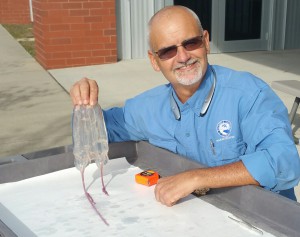
This Four-handed box jelly was found near NAS Pensacola in 2015.
Photo: Courtesy of Robert Turpin
According to NOAA and the University of California at Berkeley there are between 20-50 species of box jellies from around the world. Their distinct shape, often called “cubomedua”, places them in their own family. Most of the “medusa” jellyfish we know are in a group called “scyphozoans” but box jellies differ in several ways.
- Their shape – the “box” shaped and their tentacles are clustered into four groups on the corners of the “box”.
- They are very good swimmers – most medusa can undulate their “bells” and move but they are planktonic (drifters) in the ocean currents. Box jellies are very strong swimmers. They can move against currents, tend to swim below the surface more (often collected in shrimp trawls), and have been clocked at top speeds of 4 knots! (This is very fast for a jellyfish).
- They do have eyes. They know where they want to go, can avoid colliding with piers, and have been known to even swim away from collectors trying to catch them. Not typical of our locals jellyfish. Lacking a central nervous system like ours, science is not sure how they see, or what they see, but they do.
Box jellies are found in all tropical seas, including the south Atlantic and Gulf of Mexico. They range in size from less than an inch to about 8 inches, with tentacles extending as far as 10 feet behind. Breeding in this group is interesting. Males will place their tentacles inside the bell of the female and deposit sperm. The female will then fertilize her eggs and release planktonic larva called planula. These planula will drift in the currents for a short period before metamorphosing into a flower-like creature called a polyp. Polyps are sessile (non-swimming) and attach to hard structures on the ocean floor. Here they can move and adjust to feed with their extended tentacles and can actually produce more polyps by budding. After a period of time each polyp will metamorphose into a swimming medusa, the box jelly we know and love. As already mentioned, they swim with purpose hunting small fish and invertebrates. They do have their predators. Certain fish and sea turtles are known to consume with no ill effects.
They all possess a very strong toxin which is quite painful. The most toxic of the group is Chironex fleckeri, the famous one from Australia. This jellyfish has been listed by many, including NOAA, as the most venomous marine animal in our oceans. It has certainly caused death in their waters. The majority of the lethal box jellies live in the Indo-Pacific. So what about Florida?
I am aware of two species that have been found here. The “Four-handed Box Jelly” (Chiropsalmus quadrumanus) and the “Mangrove Box Jelly” (Tripedalia cystophora). The Four-handed box jelly is the larger of the two, and the one pictured here. The Mangrove Box Jelly typically lives in the Caribbean. The first reported in south Florida was in 2009 near Boca Raton but they have since been reported in the Keys and along the Southwest coast of Florida. This is a small box jelly (about 0.25” in diameter) and seems to prefer the prop roots of mangrove trees.
The Four-handed box jelly can reach almost 5” in length with up to 10’ of tentacles attached. It is more widespread in Florida, though more common on the Atlantic coast then our own. One was brought to me about 6 years ago. The person found it next to pier at Quietwater Boardwalk, in the evening, swimming around the lights shining in the water, it was near Thanksgiving also. The one pictured here was seen by a local surfer and by Robert Turpin (Escambia County Division of Marine Resources) last week. Both sightings were near NAS Pensacola and may have been the same animal. This box jelly has the same characteristics as others – box shape, clustered tentacles, and very painful sting. The surfer who brought me the one from 6 years ago was stung by it. He said the pain brought him to his knees… so do not handle this animal if you see one. There was a report of a small child who died after being stung by one in 1991. However there are reports of young kids dying from the Portuguese man-of-war as well. Lesson here… treat it with caution.
These box jellyfish are not the deadly ones known from Australia, and it is certainly not common here – preferring to stay in the open ocean more than nearshore, but it is an animal all should know about and avoid handling if encountered.
More resources on this animal:
http://www.sanibelseaschool.org/experience-blog/2014/9/24/5-types-of-jellies-in-the-gulf-of-mexico
http://beachhunter.net/thingstoknow/jellyfish/
http://www.ucmp.berkeley.edu/cnidaria/cubozoalh.html#Active

by Rick O'Connor | Nov 20, 2015
Everyone knows there are “sea horses”, “sea cows”, “catfish”, and “dogfish” but a ”turkeyfish”? Is there such a thing as a “turkey fish”? Well yes there is!… its scientific name is Pterois volitans but most know it as the LIONFISH. Yep, our old friend the lionfish.
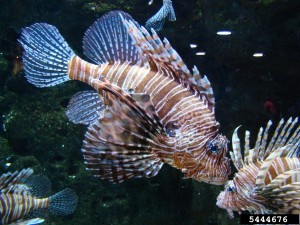
Lionfish, Photo Credit: Rebekah D. Wallace, UGA, Bugwood.org
Some of us first heard about the lionfish several years ago during trips to the Florida Keys but in recent years we are hearing about in our own local waters. Actually, some studies suggest there are more here than in the Keys. The recent red tide backs this up… we had at least 75 dead lionfish was ashore in Escambia and Santa Rosa counties; probably many more uncounted. We asked Dr. Chris Stallings of the University of South Florida whether he thought lionfish may be more susceptible to red tide toxin (brevotoxin) and he responded “probably not… you just have more lionfish in the western panhandle!”
Many of us have been hearing and reading about local lionfish since 2010 – so what is the status of this fish this Thanksgiving?
Well, they’re still here. There have been several derbies held along the panhandle over the past two years and they have removed close to 10,000 fish in Escambia County alone – but these guys breed fast and the population is still there. A few divers have obtained their salt water products license and have begun selling to local and regional restaurants. But they are having a hard time supplying fish as fast as the demand has been for them.
State and local agencies and nonprofits will continue to educate the public about the potential impacts of this invader and provide more tournaments this spring to encourage local divers to remove as many as we can. Research is ongoing for an effective, by-catch reducing, trap to be used to harvest them and Dr. Jeff Ebles with the University of West Florida will continue to survey for the fish within Pensacola Bay. All of these efforts will hopefully begin to stabilize their population growth and – eventually – a downward slide in their numbers. Until then, enjoy eating lionfish…
Hmmm… a new Thanksgiving tradition… “turkeyfish”… hmmm
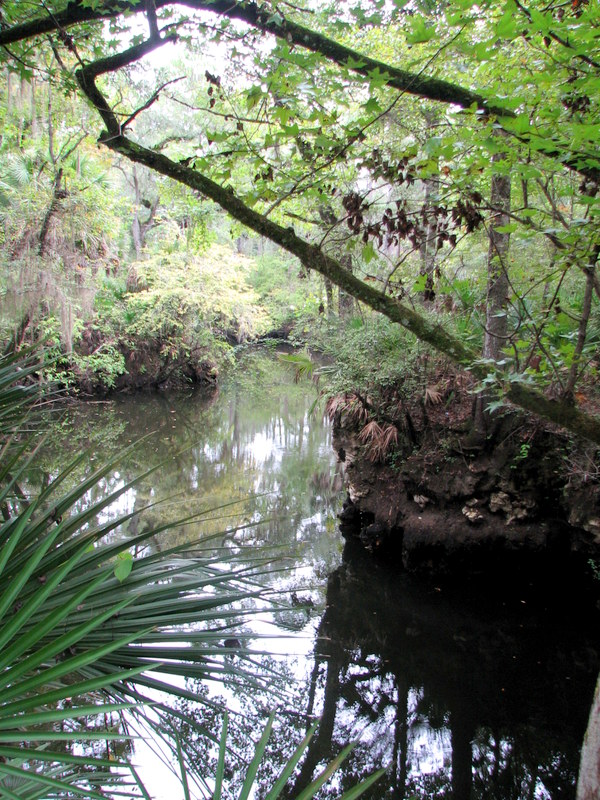
by Rick O'Connor | Nov 6, 2015
Hernando de Soto and his party crossed the Aucilla River sometime in October of 1539 and celebrated Christmas in what is now Tallahassee. Many things in Florida have changed since de Soto passed this way, but when the 2015 Panhandle Outdoors LIVE! tour hiked the Aucilla Sinks portion of the Florida Trail this September, many things had not.
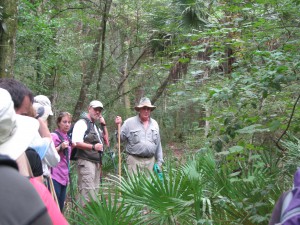
Panhandle residents explore the area of Aucilla Sinks with local guide David Ward.
Photo: Jed Dillard
Yes, the trail is maintained and marked by the Apalachee chapter of the Florida Trail Associations and there are bridges in spots, but the blood sucking bugs that bedeviled deSoto haven’t dissipated. More importantly, the spectacular and distinctive area provides a relatively easy hike that reveals the connections between geology and hydrology in an area with little disturbance by the settlers who followed the first Europeans into North Florida.
Hikers got up close and personal views of the Karst topography found in North Florida. This topography occurs as the tannic rivers and runoff dissolve the underlying limestone on their way to the aquifer. These connections and voids in the bedrock allow the Aucilla River to “come and go” above and below ground as it moves to the Gulf of Mexico as do all rivers in the Suwannee River Water Management District other than the Suwannee.
Native Jefferson county guide, David Ward pointed out the contrast between tannic water in the river channel and the clear water in caves near the river. “In those caves the water is crystal clear. You are looking at the water of the aquifer itself.”
Leon County agent Will Sheftall seized the opportunity to drive home how vulnerable Floridians are to ground water pollution and its effects on our water supply. “Here there’s little distance between the surface and the ground water. In these sandy soils, water moves quickly from the surface to the aquifer. Whatever is in that water can easily get into our ground water. Our personal activities and our public policies need to reflect that to ensure the future of Florida’s water quality.”
As we reached a slightly elevated area, Ward pointed out a longleaf pine/wiregrass community restored by reinstituting controlled burning. The open vegetation contrasts with the non-fire resistant species such as parsley hawthorn in wetter areas usually untouched by fire. “These pine savannahs were widespread when the Europeans arrived,” Ward noted. “Over my lifetime in these woods, I’ve seen appropriate management bring back these conditions closer to what we know it was like when the Europeans arrived.”
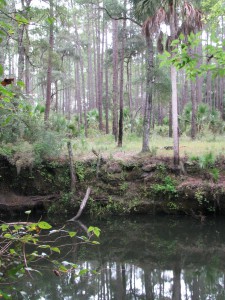
One of the many locations where the Aucilla River “rises from the limestone caverns beneath the earth.
Photo: Jed Dillard
Information on this section of the Florida Trail is available from the Apalachee Chapter of the Florida Trail Association, the Suwannee River Water Management District and Florida Fish and Wildlife Conservation Commission. Humidity never went below 80 percent during our late morning, early afternoon trip. November will likely provide less buggy and surely less muggy conditions. If you’d like to learn about this area from the comfort of your recliner or need some extra encouragement to strike out on the walk, check out this program previously broadcast by WFSU TV. http://wfsu.org/dimensions/viewvideo.php?num=184 Either way, you’ll know more about Florida’s spectacular natural world.
AUTHOR: Jed Dillard; Livestock and Forges Extension Agent; Jefferson County
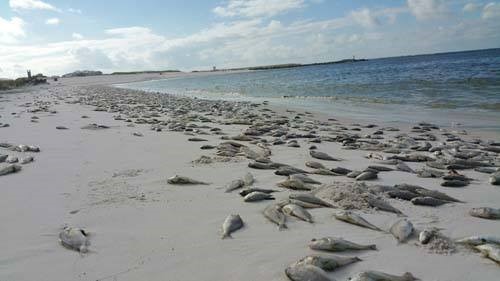
by Rick O'Connor | Oct 31, 2015
Many coastal Panhandlers woke up this week to the sight and smell of dead fish. Thousands of them washed ashore from Panama City to Pensacola. This mass die off included a variety of species including whiting, sheepshead, hake, cusk eels, and even lionfish; there were also reports of dead bass from the Dune Lakes in Walton and Okaloosa counties. What caused this mass die off of fish?
The suspect is red tide…
Most of us along the panhandle have heard of red tide but we may not know what it is or what causes it. Many attribute the red tide events to human impacts, stormwater runoff etc., but in fact they have been around for centuries. There are records suggesting that the European colonials experienced them and I have read one account that the Red Sea got its name from the frequency of these events there. So what is this “red tide” and what causes it?
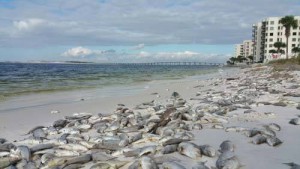
Dead fish line the beaches of Panama City.
Photo: Randy Robinson
It is actually a bloom of small single celled plants called dinoflagellates. There are thousands of species of dinoflagellates in the world’s oceans and not all cause red tide, but there are several species that do. These small microscopic plants drift near the surface of the ocean acquiring sunlight to photosynthesize. They possess two small “hairs” called flagella (hence the name “dinoflagellate”) to help orient themselves in the water column. Most have a shell covering their body called a theca and some shells have small spines to increase their surface area to resist sinking. One method of defense found in some dinoflagellates is the production of light – bioluminescence. This light is produced by a chemical reaction triggered by the creature as a flash of blue – many locals refer to it as “phosphorus”. Other dinoflagellates instead will release a toxin… some of these are ones we call “red tide”.
Red tide organisms are always in the water column of marine environments but are usually in low concentrations, maybe 300-500 cells per milliliter of water. But under favorable conditions, warm water with nutrients, they multiple… sometimes in great numbers, such as 3000-5000 cells/ml, and we have a “bloom”. The number of cells within these blooms can be high enough that we can actually see the water change color… hence “red tide”.
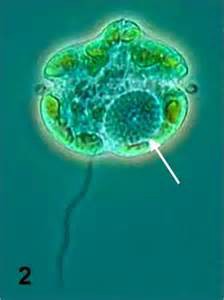
The dinoflagellate Karenia brevis.
Photo: Smithsonian Marine Station-Ft. Pierce FL
The most common red tide dinoflagellate associated with the Gulf of Mexico is Karenia brevis. Karenia blooms typically form offshore and are of little impact to the coastal communities. However when the wind and tides are right these blooms will drift towards shore. When they do fish kills occur and humans have eye and throat irritations. Marine mammals in particular struggle with red tide. As the bloom comes near shore it reaches the bottom of the water column and many of the bottom dwelling fish suffer. Most of the photos of fish I saw in the October 2015 fish kill were bottom dwellers, including many invasive lionfish.
Is there anything we can do to prevent red tides?
Not really… Again, they are naturally occurring event. We may increase the frequency of the events by discharging excessive nutrients into the water from our run-off but they would probably occur anyway. Red tide events are not as common in the panhandle as they are in southwest Florida. The Gulf waters near Charlotte Harbor are shallow, warm, and near the many manicured lawns, gold courses, and the discharge of much of the agriculture in the state. Occasionally blooms formed in that part of the state drift north but this year a bloom formed off of Bay and Gulf counties in early October. The recent storm that passed through probably pushed the bloom inland and to the west. The biggest hazard of humans is eye, throat, and skin irritation. It is quite uncomfortable to be around these blooms. In 1996 a local bloom was concentrated enough that the campground at Ft. Pickens had to be closed. I was in Galveston Texas when I heard about the red tide occurring in the Florida panhandle. As I was leaving Galveston the newspaper reported the closer of all oyster harvesting in Texas due to a red tide generated in the Padre Island area and was moving north. Seems that red tide is covering a large portion of the Gulf coast the last week of October. That said… anything communities can do to reduce nutrient runoff will certain decrease the frequency of red tides.
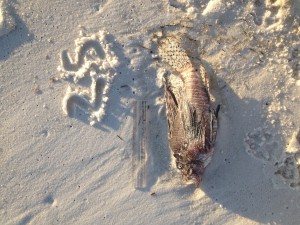
The carcass of the invasive lionfish was part of the October red tide kill.
Photo: Shelly Marshall
The Florida Fish and Wildlife Conservation Commission post red tide updates from around the state on their website and the Escambia County Extension Office post a local water quality update each Friday that has red tide information as well.
FWC
http://myfwc.com/research/redtide/
Escambia County Extension
http://escambia.ifas.ufl.edu
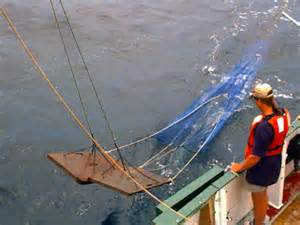
by Rick O'Connor | Oct 31, 2015
So what now?
What lies ahead for the seafood industry in the Florida Panhandle?
Well I will start by saying I do not have a crystal ball… so I truly do not know, but most people plan for the future and many have looked at what COULD happen for Florida seafood.
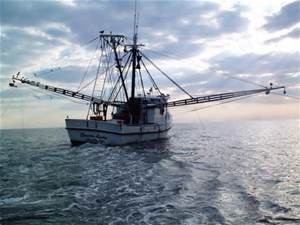
Shrimping.
Photo: NOAA
Will the demand for seafood still be there in the future?
In short… yes
Recent reports indicate that Americans are not consuming the recommended 3-6 ounces of seafood a week. Though many Floridians are not consuming this amount either they are consuming above the national average of 3.5 ounces. Seafood is still important to us. Community fish fries are a part of our culture and will be around. The popularity of sushi and other methods of preparing seafood has increased in recent years. There will be a demand for some seafood products. In the Pensacola area there has been recent interest in buying local seafood. Whether they are willing to pay higher prices than the foreign imports is to be seen but there is still a market for seafood products.
Can the seafood industry meet this demand?
That depends…
Several commercially valuable species have been deemed “overfished”. If the demand for these products increases there could be a problem meeting due to either regulations forbidding the industry to do so, or the numbers of fish available may make it prohibitive. For some species they may become part of a smaller higher paying market. There may be new species introduced that could be marketed and meet the demand, lionfish for example. The demand for this fish is growing but the availability is still low due to method of capture. At the moment the most effective method of harvesting lionfish is by spearing. We do not have enough divers to meet the 500 lbs. of fish / week/ restaurant currently requested. But there is another option to consider… aquaculture.
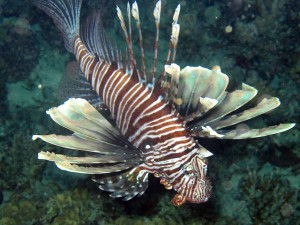
Humans have been growing our food for centuries (agriculture). There are few societies on our planet today they acquire their meat and vegetables solely by hunting and gathering. Aquaculture has also been around for centuries as well, just not in the United States. With the increasing world population, and the need for food along with it, scientists have been working on more efficient ways to produce food for over 100 years. The “green revolution” appeared in the mid 20th century and the impact was huge. The American food machine was churning out products like never before. It did come with a price for the environment around the farms, and there is concern now about the problems with high densities in some livestock operations, but the food is there. Many scientists believe aquaculture will be the method to meet the future seafood demand. Many are not surprised to learn that farm raised fish is common in most supermarkets, but they may be surprised to learn that 80-90% of it is imported from overseas. When we hear “farm raised” we immediately think of Mississippi catfish… which is local right? But in fact much of it is from Asia and Central America.
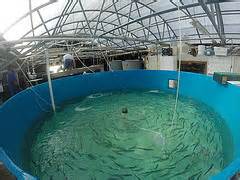
Indoor aquaculture projects are found throughout Florida.
Photo: Florida Sea Grant
Will aquaculture increase in the Florida panhandle and will the public be okay with it?
I do not know.
Many Florida Panhandlers catch their own seafood, and there have been issues between the recreational and commercial fishermen for a few years now. Either way many Panhandlers will seek out fresh local seafood and provide it for their families. Whether they will embrace aquaculture is to be seen.
Either way seafood should be a part of our weekly diet. For many, the post oil spill fear of safety is no longer a concern. There is science that indicates our seafood is safe to eat. The concerns about mercury are real but low consumption of mercury target species (no more than one serving a week) has been deemed safe. For pregnant women (or women trying to become pregnant) this fear has kept them away from all seafood during their pregnancy. A recent study showed that there are important nutrients and vitamins provided in seafood products that are much needed during development and some women are not getting these. The recommendation here is to eat seafood but consume products not high in mercury. There are several agencies who post which species are high in mercury and which are low.
The seafood industry is an important part of panhandle history and culture. Though the industry has fallen on tough times I feel some form of commercial fishing will be around for a few years. We hope you learned something from this series during National Seafood Month and encourage you to ENJOY GULF SEAFOOD!
Additional resources:
Pregnancy
http://americanpregnancy.org/pregnancy-health/mercury-levels-in-fish/
mercury list
http://www.fda.gov/Food/FoodborneIllnessContaminants/Metals/ucm115644.htm
Florida Department of Health – seafood safety
http://www.floridahealth.gov/programs-and-services/prevention/healthy-weight/nutrition/seafood-consumption/fish-advisories-page.html
FWC – mercury
http://myfwc.com/research/saltwater/health/mercury/human-health-advisories/
Florida Sea Grant
http://www.flseagrant.org/seafood/
NOAA-NMFS seafood recommendations
http://www.nmfs.noaa.gov/aquaculture/faqs/faq_seafood_health.html#5how















